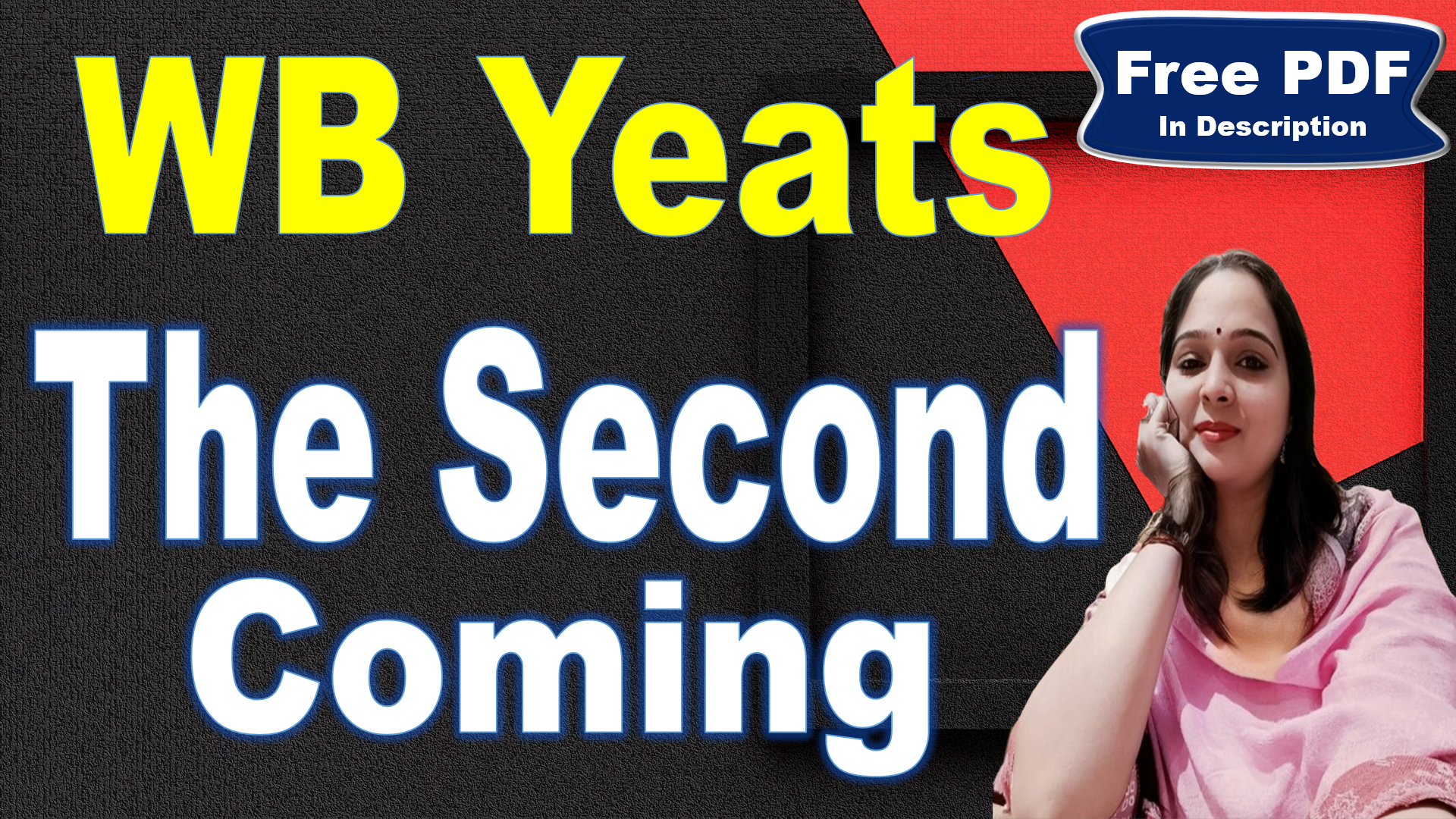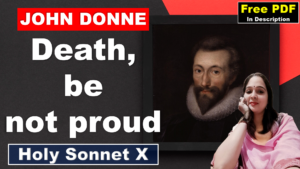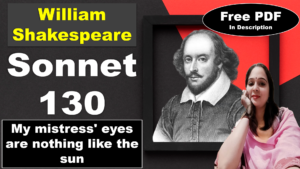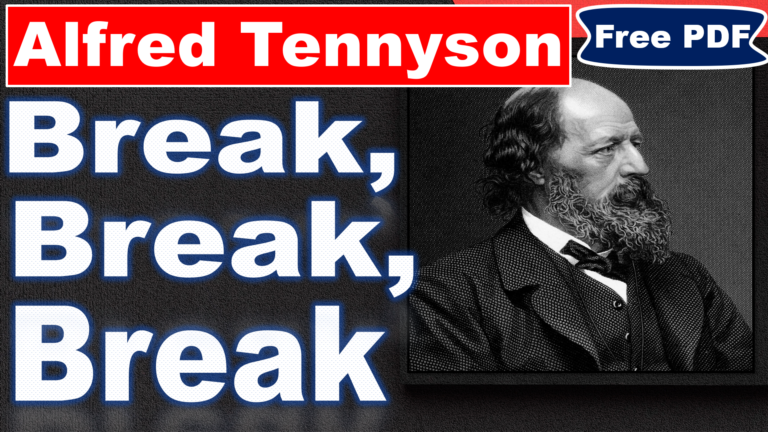Essay Type Questions
Write the critical appreciation of the poem.
Introduction
William Butler Yeats’s poem “The Second Coming” is a powerful and enigmatic work that delves into themes of chaos, transformation, and the cyclical nature of history. Written in 1919, shortly after World War I, the poem captures the anxiety and disillusionment of an era marked by upheaval. Through vivid imagery and prophetic language, Yeats explores the collapse of societal norms and the anticipation of a significant event.
Central Idea
The central idea of the poem revolves around the concept of a second coming—an alternative to the Christian notion of Jesus’s return. Yeats envisions a world in turmoil, where traditional certainties crumble, and a mysterious force emerges to reshape humanity’s fate.
Structure & Rhyme Scheme
Form: The poem consists of two stanzas, with irregular line lengths.
Rhyme Scheme: There is no consistent rhyme scheme, emphasizing the chaotic content.
Meter: The poem follows iambic pentameter, maintaining a rhythmic flow.
Theme
Chaos and Disintegration:
The poem vividly portrays a world in turmoil, where established norms crumble.
The widening gyre symbolizes disorientation and societal collapse.
Chaos, fragmentation, and loss of order permeate the poem.
Fear of the Unknown:
The anticipation of a revelation—the Second Coming—adds urgency.
The vision of a grotesque beast replaces traditional religious expectations.
Uncertainty and existential dread characterize the speaker’s perspective.
Spiritual and Historical Cycles:
Yeats’s personal theory of “gyres” reflects alternating cycles of history.
The poem suggests that humanity is caught in a perpetual cycle of rise and fall.
The Second Coming represents a significant turning point in this cyclical pattern.
Violence and Apocalypse:
The blood-dimmed tide symbolizes upheaval, violence, and destruction.
The monstrous figure emerging from the desert embodies impending catastrophe.
The closing question about the “rough beast” hints at an apocalyptic event.
Loss of Faith and Conviction:
The best lack conviction, while the worst are full of passionate intensity.
Society’s polarization and moral confusion are evident.
The collapse of traditional beliefs contributes to the prevailing chaos.
Interplay Between Mundane and Divine:
Yeats blends Christian allegory with mystical elements.
The falconer, Spiritus Mundi, and Bethlehem add layers of meaning.
The poem explores the tension between earthly realities and transcendent forces.
Style
Imagery and Symbolism:
Yeats employs vivid imagery: falcon, gyre, blood-dimmed tide, desert, and the rough beast.
Symbolism includes the falconer (authority), Spiritus Mundi (collective consciousness), and Bethlehem (birthplace).
Prophetic Language:
The poem’s tone is urgent and prophetic.
Yeats hints at an impending cataclysmic event.
Poetic Devices
1. Symbolism
Falcon and Falconer: The falcon represents freedom and the human spirit, while the falconer symbolizes control and order. The falcon losing touch with the falconer symbolizes the breakdown of societal and moral order.
Gyre: The gyre is a symbol of cyclical patterns in history. It represents the widening chaos and the cyclical nature of historical and spiritual events.
Rough Beast: This beast symbolizes a new era or force that is both terrifying and inevitable. It could be seen as a symbol of the antichrist or a destructive force that will replace the old order.
2. Imagery
Visual Imagery: The poem is rich with visual imagery, such as “turning and turning in the widening gyre,” “the blood-dimmed tide,” and “a shape with lion body and the head of a man.”
Dark and Foreboding Imagery: Phrases like “the darkness drops again,” “the blood-dimmed tide is loosed,” and “the ceremony of innocence is drowned” evoke a sense of dread and impending doom.
3. Allusion
Christian Eschatology: The poem alludes to the Second Coming of Christ, a concept in Christian eschatology. However, Yeats subverts this by presenting a vision of a monstrous birth rather than a redemptive one.
Spiritus Mundi: This refers to the world soul or collective unconscious, a concept from Yeats’s own mystical system, indicating that the vision he describes comes from a deeper, universal source.
4. Metaphor
Widening Gyre: The gyre is a metaphor for the expanding chaos in the world. It represents the way things are falling apart and spiraling out of control.
Blood-dimmed Tide: This metaphor signifies widespread violence and bloodshed, suggesting that society is being overwhelmed by a tide of destruction.
5. Personification
Anarchy is loosed upon the world: Anarchy is given human attributes, suggesting it is an active force that is being released upon the world.
The darkness drops again: Darkness is personified as if it has the ability to fall like a curtain, emphasizing the return of chaos and uncertainty.
6. Irony
The Second Coming: Traditionally, the Second Coming is associated with hope and salvation. Yeats uses irony by depicting it as a time of terror and the rise of a monstrous entity.
7. Paradox
The centre cannot hold: This paradoxical statement suggests that the central, stabilizing forces in society are no longer effective, leading to widespread chaos.
8. Rhetorical Question
And what rough beast, its hour come round at last, Slouches towards Bethlehem to be born?: This rhetorical question at the end of the poem leaves the reader contemplating the nature of the new era that is dawning.
9. Enjambment
Yeats uses enjambment to create a sense of continuity and fluidity, reflecting the unstoppable progression of chaos. For example, “The blood-dimmed tide is loosed, and everywhere / The ceremony of innocence is drowned” flows from one line to the next without pause.
10. Caesura
The darkness drops again; but now I know: The use of a caesura (a pause) in this line emphasizes the shift from the description of the vision to the speaker’s realization of its significance.
11. Antithesis
The best lack all conviction, while the worst / Are full of passionate intensity: This antithesis contrasts the apathy of the good with the fervor of the wicked, highlighting the poem’s theme of moral disintegration.
12. Symploce
Surely some revelation is at hand; / Surely the Second Coming is at hand: The combination of anaphora and epiphora (that is, the repetition of words or phrases at both the beginning and end of successive clauses) is called symploce.
Critical Commentary
T.S. Eliot: Eliot praised the poem’s “terrifying beauty” and its ability to capture the zeitgeist of the post-war era.
Other Critics: Interpretations vary—some see hope in the chaos, while others emphasize despair.
Message
The world is undergoing profound transformation.
Established norms collapse, and uncertainty prevails.
The poem leaves readers with a sense of foreboding and existential anxiety.
Conclusion
“The Second Coming” remains relevant, resonating with readers across generations. Its haunting language and prophetic vision continue to provoke contemplation about the human condition and the cycles of history.










